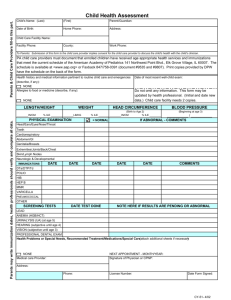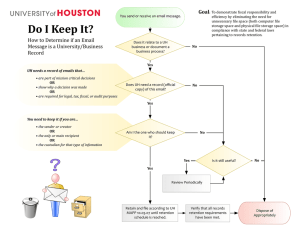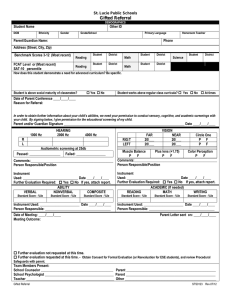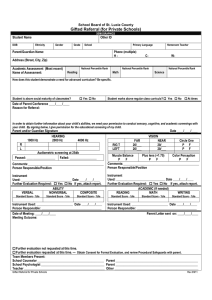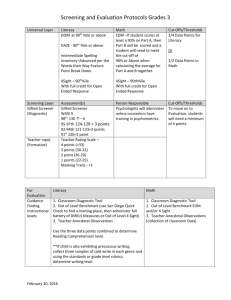A Meta-Model to Acquire Relevant Knowledge for - LIRIS
advertisement
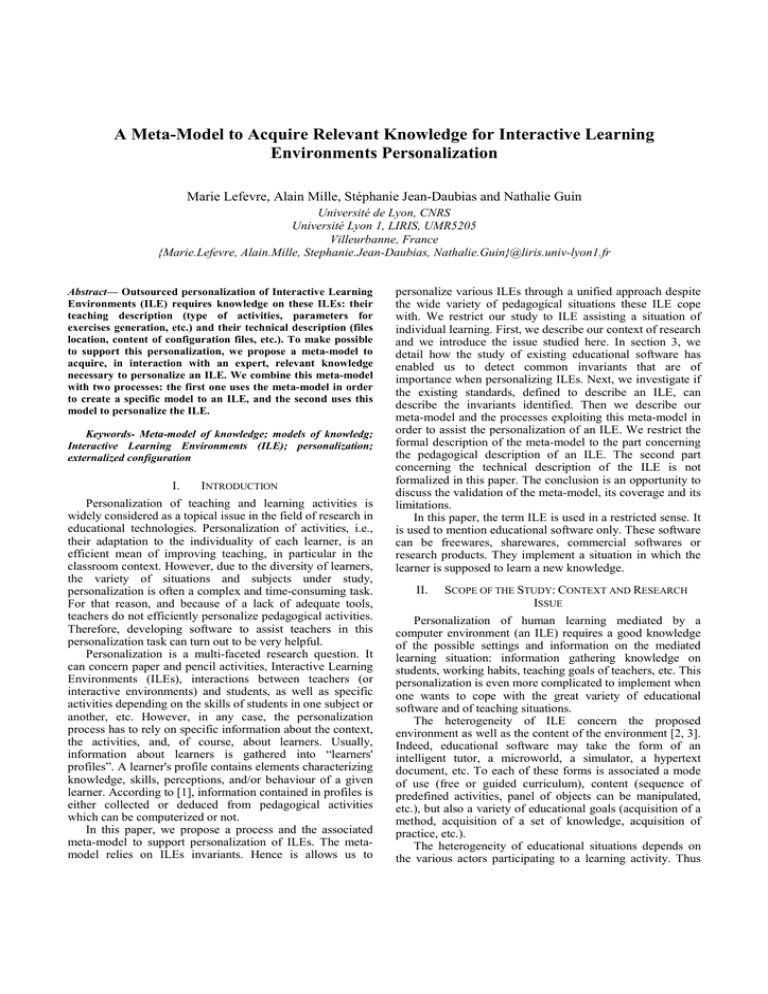
A Meta-Model to Acquire Relevant Knowledge for Interactive Learning
Environments Personalization
Marie Lefevre, Alain Mille, Stéphanie Jean-Daubias and Nathalie Guin
Université de Lyon, CNRS
Université Lyon 1, LIRIS, UMR5205
Villeurbanne, France
{Marie.Lefevre, Alain.Mille, Stephanie.Jean-Daubias, Nathalie.Guin}@liris.univ-lyon1.fr
Abstract— Outsourced personalization of Interactive Learning
Environments (ILE) requires knowledge on these ILEs: their
teaching description (type of activities, parameters for
exercises generation, etc.) and their technical description (files
location, content of configuration files, etc.). To make possible
to support this personalization, we propose a meta-model to
acquire, in interaction with an expert, relevant knowledge
necessary to personalize an ILE. We combine this meta-model
with two processes: the first one uses the meta-model in order
to create a specific model to an ILE, and the second uses this
model to personalize the ILE.
Keywords- Meta-model of knowledge; models of knowledg;
Interactive Learning Environments (ILE); personalization;
externalized configuration
I.
INTRODUCTION
Personalization of teaching and learning activities is
widely considered as a topical issue in the field of research in
educational technologies. Personalization of activities, i.e.,
their adaptation to the individuality of each learner, is an
efficient mean of improving teaching, in particular in the
classroom context. However, due to the diversity of learners,
the variety of situations and subjects under study,
personalization is often a complex and time-consuming task.
For that reason, and because of a lack of adequate tools,
teachers do not efficiently personalize pedagogical activities.
Therefore, developing software to assist teachers in this
personalization task can turn out to be very helpful.
Personalization is a multi-faceted research question. It
can concern paper and pencil activities, Interactive Learning
Environments (ILEs), interactions between teachers (or
interactive environments) and students, as well as specific
activities depending on the skills of students in one subject or
another, etc. However, in any case, the personalization
process has to rely on specific information about the context,
the activities, and, of course, about learners. Usually,
information about learners is gathered into “learners'
profiles”. A learner's profile contains elements characterizing
knowledge, skills, perceptions, and/or behaviour of a given
learner. According to [1], information contained in profiles is
either collected or deduced from pedagogical activities
which can be computerized or not.
In this paper, we propose a process and the associated
meta-model to support personalization of ILEs. The metamodel relies on ILEs invariants. Hence is allows us to
personalize various ILEs through a unified approach despite
the wide variety of pedagogical situations these ILE cope
with. We restrict our study to ILE assisting a situation of
individual learning. First, we describe our context of research
and we introduce the issue studied here. In section 3, we
detail how the study of existing educational software has
enabled us to detect common invariants that are of
importance when personalizing ILEs. Next, we investigate if
the existing standards, defined to describe an ILE, can
describe the invariants identified. Then we describe our
meta-model and the processes exploiting this meta-model in
order to assist the personalization of an ILE. We restrict the
formal description of the meta-model to the part concerning
the pedagogical description of an ILE. The second part
concerning the technical description of the ILE is not
formalized in this paper. The conclusion is an opportunity to
discuss the validation of the meta-model, its coverage and its
limitations.
In this paper, the term ILE is used in a restricted sense. It
is used to mention educational software only. These software
can be freewares, sharewares, commercial softwares or
research products. They implement a situation in which the
learner is supposed to learn a new knowledge.
SCOPE OF THE STUDY: CONTEXT AND RESEARCH
ISSUE
Personalization of human learning mediated by a
computer environment (an ILE) requires a good knowledge
of the possible settings and information on the mediated
learning situation: information gathering knowledge on
students, working habits, teaching goals of teachers, etc. This
personalization is even more complicated to implement when
one wants to cope with the great variety of educational
software and of teaching situations.
The heterogeneity of ILE concern the proposed
environment as well as the content of the environment [2, 3].
Indeed, educational software may take the form of an
intelligent tutor, a microworld, a simulator, a hypertext
document, etc. To each of these forms is associated a mode
of use (free or guided curriculum), content (sequence of
predefined activities, panel of objects can be manipulated,
etc.), but also a variety of educational goals (acquisition of a
method, acquisition of a set of knowledge, acquisition of
practice, etc.).
The heterogeneity of educational situations depends on
the various actors participating to a learning activity. Thus
II.
ILEs can support individual learning situation, collective
learning situation or collaborative learning situation. The
teacher may have a role of the designer of an activity or tutor
of an activity.
To cope with this double heterogeneity (ILE and
educational situations), the teacher must be able to configure
ILE in order to satisfy his own pedagogical goals and to
build different types of profiles enabling him to manage
personalized educational situations for learners.
In this research, we restrict our study to the case of the
teacher which prepares a learning situation by personalizing
an ILE and by preparing the appropriate profiles to manage
this situation; and to the case of an individual learning
situation, even if it is likely that we could have a similar
approach to collective learning situation.
This personalization uses profiles of learners [1]: profiles
designed by teachers regardless of a particular ILE and
profiles designed for concerned ILEs, regardless of a
particular teacher. Personalization is done in accordance with
the educational goals chosen by the teacher to the prepared
learning situation.
We rely on the EPROFILEA environment (PERLEA
project [1, 4]) as support to the process of personalization.
EPROFILEA consists of a set of modules: module for
description of profiles structures, modules for integration of
date profile, module for visualization, etc. Our meta-model
aims at supporting efficiently the personalization process of
any ILE. Indeed, it guides the design of models dedicated to
the configuration of ILEs. In the same way, it supports the
design of models of profiles associated to specific
pedagogical goals. As a consequence, this meta-model helps
to prepare an individual learning situation with a given ILE.
This meta-model is implemented in a new module of
EPROFILEA: the Adapte module [5].
Defining such a meta-model requires to identify the
invariants which exist in the models of individual learning
activities and in the models of ILE’s settings. For this
purpose, we have analysed 30 ILES and we have studied
how learning activities were described, by focusing in
particular on standardized descriptions.
III.
A SURVEY OF EXISTING SYSTEMS AND STANDARDS
In this section, we address the issue of the description of
an ILE for personalization and then how the metadata allow
describing an ILE.
A. Describing an ILE for Personalization
In order to allow a personalization of an ILE, it is
necessary to have information (knowledge, skills, etc.) on the
learner for which the personalized ILE will be designed, but
also on the situation in which this ILE will be used (place,
time, pedagogical goal of the teacher). The information on
the learner may be contained in a profile of learner, but
information on the educational situation should be described
by the teacher himself. From this information, it is possible
to change the ILE to adapt it on the one hand to the learner
and the other hand to educational goals of the teacher.
In order to determine the main types of personalization in
an ILE and the way it can be implemented, we have
conducted a systematic study of 30 ILEs. These ILEs are of
different types: intelligent tutors as Andes [6] or AMBREadd [7], microworlds as Aplusix [8], simulators as Teleos [9]
or web applications as ActiveMath [10]. Some of them come
from research as SQL-Tutor [11], or from practices of
teachers as LiliMath [12], or from free development as
Mathenpoche [13] or from commercial softwares as
Exomatiks [14]. Moreover, they are intended to various
public from nursery school to high school and for
professional training. They cover various learning areas
(mathematics, orthopaedic surgery, German, etc.).
We have determined that in these ILE, personalization
may include: the proposed activities, the sequence of
activities (number of activities, order), available
functionalities, the feedback offered to learners and the
customization of ILE’s interfaces. These targets of
personalization are confirmed from a theoretical point of
view in the literature studying the techniques used to adapt
systems [15].
The Table 1 provides an overview of personalization
possibilities, choosing typical examples among studied ILEs.
The columns in this table reflect the five targets of
personalization that we have identified.
TABLE I.
ILES
OVERVIEW OF POSSIBLE PERSONALIZATIONS IN VARIOUS
ILE
AMBRE-add [7]
Aplusix [8]
Téléos [9]
Mathenpoche [13]
LiliMath [12]
Exomatiks [14]
ActiveMath [10]
Andes [6]
Activities
X
X
X
X
X
X
X
X
Sequence of
activities
X
Functionalities
X
X
Feedback
Interface
X
X
X
X
X
After having identified five targets of personalization, we
focused on how implementing this personalization. To do
this, we studied how ILEs could be “configured” when used
by the learner.
An ILE is usually set up by a configuration file or a
configuration interface. Activities can then be generated
automatically or selected from a predefined list, possibly in
compliance with the constraints expressed by the settings.
Fig 1. summarizes these different cases giving, each time,
examples of ILEs operating in this manner.
Figure 1. Categorization of ways to customize an ILE.
Finally, to know how to act from outside the ILE on its
parameters, we studied the different configuration files as
well as the interfaces that have an impact on system setting.
We give below some examples to determine how to discover
the invariants in the personalization process. Indeed, the
normalization process needs to match the setting information
as accessible to the user and the information to adapt the ILE
to implement the desired personalization.
First example, the AMBRE-add ITS [12] has an
exercises generator allowing to act on the creation of an
activity. The configuration file (see an extract in Fig. 2) of
the generator contains, among others, the value of each
parameter necessary for the creation of exercises. This
configuration file is made up of specific codes for adapting
the AMBRE-add ITS.
Taking the first code of the configuration file
“['c_comparaison_dif','de plus']”, it corresponds actually, for
the first field, to the value of a parameter “classe de
problème”, scale_list type, whose possible values (explicitly
provided to the user in the graphical environment) are
“réunion, changement, comparaison”, concatenated to the
value of the associated parameter “place de l'inconnue”,
scale_list type, whose possible values are “résultat,
opérande, opérateur, différence, un des deux – min, un des
deux– max” and for the second field, to the value of a
parameter “variation”, also scale_list type, and whose
possible values are “augmentation, diminution”. Shown here
that under the apparent specificity of the configuration file,
there is a setting, relatively quite simple, to choose the values
in predefined lists. We have put in italic the values of the
lists corresponding to the code used in the configuration file
example.
In the same way, taking the fifth parameter of
configuration file “[0,0,1,0]”, it corresponds to the value of
parameters “utiliser une seule sorte d'objets”, “utiliser
plusieurs sortes d'objets”, “affecter les objets” and “affecter
les personages”, all scale_boolean type. The reader will
easily understand that true is represented by 1 and false by 0.
To conclude this example with another type of parameter,
we choose the sixth parameter of the configuration file
[5,15], it corresponds to the value of the parameter
“intervalles pour les valeurs”, scale_interval type, and
possible values in [LowerBound = 0..∞, Upperbound = 0..∞].
Second example, in the Aplusix microworld [8], the
learner can obtain a sequence of activities through a test
card which is represented by a table with double entries. This
test card is available from the interface of the ILE. The rows
of table corresponding to the types of calculation can be:
“numeric calculation (A), development and resolution (B),
factoring (C), solving equation (D), resolution inequality (E),
solving system (F)” and the columns correspond to the level
of difficulty between 1 and 9. Some cases of the table are
inactive, such as A6, A7, A8 and A9. The learner then
chooses one case of the table and the ILE generates exercises
corresponding to the type of calculation and at the level
requested. The card test can be described with the parameter
“type of calculation”, scale_list type, whose possible values
are “A, B, C, D, E, F” and with the parameter “level”,
scale_numerical type, of values between 1 and 9. These two
parameters are constrained by a set of rules like “If {Value
(type of calculation) = A} Then {ValueDomain(level) =
1..5}”.
Third example, in the Andes Physics Tutor [6], the
learner may request to do an activity by selecting, from
menus of the interface, the subject among those of one
discipline then the number of the activity.These menus can
be described by three parameters. The first parameter is the
“discipline”, scale_list type, whose values are “mechanics,
electricity and magnetism”. The second parameter is the
“subject”, scale_list type, whose an overview of the values is
“vectors, translational kinematics, free body diagrams, static,
etc.”. The third parameter is the “number of exercise”,
scale_list type, whose an overview of values is “vect1a, ...,
relvec3a, ..., mirror1, mirror2, ...”. These three parameters
are constrained by a set of rules like “If {Value (subject) =
vectors} Then {ValueDomain(number of exercise) =
“vect1a, ..., relvec3a”}”.
Last example, in the Exomatiks software [14],
functionalities and interface of the software (language,
graphic options, tools, users, etc.) are defined from a
configuration file (see Fig. 3). Taking the code “langue=0”,
it corresponds to the value of parameter “language”,
scale_list type, whose possible values are “French, English,
etc.” and the value of the file indicates the index of the
enumerated list.
appel_generation([
['c_comparaison_dif'
,
'de plus'],[jeu],
['bille','bille
jaune',
'bille jaune'],
[],[0,0,1,0],[5,15],
[],
[intervalle,1],[0,2,
0,1,0,0]],apercu).
Figure 2. Excerpt from
configuration file for the
generation of exercises in
AMBRE-add ITS.
[generales]
langue=0
…
[Internet]
utiliser_ie=1
…
[outils]
executer=-1
auto_mutiplier=1
auto_reduction=0
activer_coloration=1
…
Figure 3. Excerpt from configuration
file for interface and functionalities of
the Exomatiks software.
Through these examples, we can see that it is possible to
describe the parameters involved in setting of an ILE through
a common formalism : a set of parameters constrained by a
set of rules. These parameters are of predefined types
(scale_list, scale_boolean, etc.) and their values are
dependent on the ILE to configure.
At the conclusion of the study that we made on 30 ILEs,
we can observe that the personalization of an ILE may cover
five targets: the selection or the creation of activities, the
organisation of these activities to form working sequences,
the functionalities offered to the learner, the feedback offered
by the ILE and the interface of the ILE. Parameters acting on
these targets may be contained in files or be changed via a
configuration interface in the ILE.
Each of these parameters can be described using a
common formalism. Thus these parameters can be presented
in a uniform way for a teacher and thus allow easier
personalization of heterogeneous ILE. The parameters
influencing the ILE must be accompanied by pedagogical
competences associated with them. Indeed, for a teacher can
change the setting of an ILE, he needs to know what
competence is associated with each setting and what
influence will get change from one parameter to ILE.
In conclusion, we can say that in order to personalize an
ILE in outsourced way, we need to know the parameters
impacting on the setting of the software, the competences
associated with changing these settings and a technical
description on how, from the values of each parameter, to
modify or to create the configuration files. We therefore
examined the existing standards to see if they allow us to
describe an ILE according to this granularity.
B. Describing an ILE Using Metadata
The question of ILE description has historically quickly
asked to enable the sharing and reuse of resources within
them. Several proposals for standardization have been made
with different objectives. The Dublin Core includes a set of
general metadata to describe all types of resources [16] [17]
while others standards are more specific to areas or to
professions. With regard to educational resources, we can
cite LOM, which allows us to describe the educational tools
[18], notably e-learning softwares, or SCORM which allows
us to create interoperable and reusable structured teaching
objects [19]. These standards are not suitable for the
description of components constituting ILEs because they do
not have enough metadata to describe the software
appearance of these components, such as technical needs
(hardware and software) to run it, their characteristics
(services, properties, methods) and let-alone rules and
dependencies required to assemble it by computer specialist
developing ILEs.
In response to this observation, the software component
description pattern LSCM proposes a set of metadata
devoted to software components [20]. LSCM has two
sections: a common section to all classes of components
describing software engineering, and a specific section to the
category of educational software components describing the
pedagogical and didactic appearance of software component.
Hence, LSCM allows us to describe components for reuse,
but not for personalization.
Thus, the various standards proposed in current work do
not offer solutions to describe systems for personalization.
They do not permit a description of their educational content
allowing personalization. They not do either a description of
technical knowledge allowing stepping in the system to
implement this outsourced personalization.
IV. AKEPI, A META-MODEL TO ACQUIRE KNOWLEDGE
NECESSARY FOR OUTSOURCED PERSONALIZATION OF ILES
The outsourced personalization of an ILE requires
obtaining some knowledge on the ILE. First, the properties
characterizing the activities and the environment, allow for
each ILE, to know the type of proposed activities and how it
is possible to choose or generate activities by this ILE. These
properties also permit to know if the ILE proposes
customizable sequences of activities, customizable
functionalities… To personalize the environment and
activities offered to learners, it is necessary to have a
description of all the parameters relating to activities,
sequences of activities, functionalities and / or interface of
the ILE. Then, teaching competences associated with these
properties allow teachers to be assisted when making
educational choices when setting the ILE. Finally, to be able
to act on an ILE, it is necessary to be able to modify files
allowing personalization. It is therefore necessary to have
technical information on the ILE, as the presence of an
exercise generator, the place and content of configuration
files, etc.
A. Why a Meta-Model?
The AKEPI meta-model (Acquisition of Knowledge
Enabling Personalization of ILEs) is designed to facilitate the
expert’s complex task of identifying knowledge needed to
the outsource personalization of an ILE. This meta-model
defines the type of information needed to personalize an ILE
and is made up of two parts: the pedagogical description of
an ILE and the technical description (see Fig. 4). We
combine two processes with this meta-model: the first one,
AKASI, instantiates the AKEPI meta-model with specific
knowledge to an ILE α to get the OKEP/α model
(Operational Knowledge Enabling Personalization of the ILE
α), and the second one, OPIKSI, uses the OKEP/α model to
personalize the ILE α.
Figure 4. Overview of the AKEPI meta-model and associated processes.
B. Knowledge of the Meta-Model
The AKEPI meta-model defines the type of information
an expert must provide to create, for an ILE α, the OKEP/α
model allowing its outsourced personalization. This
information should cover the pedagogical description and the
technical description of ILEs (see Fig. 4). The pedagogical
description aggregates the customizable properties of a
system, with the associated competences, and the rules to
manage these properties. The technical description
aggregates all the necessary information to act concretely on
the system: localization of the system, folder of the exercises
generator or exercises database, place and content of
configuration files and rules for fill in these files. In its
implementation, the AKEPI meta-model is defined using the
XML Schema formalism [21].
In the remainder of this section, we describe the ILE
pedagogical description model of the AKEPI meta-model.
This model is composed of the model of pedagogical
properties and the model of pedagogical rules.
1) The Model of Pedagogical Properties
Fig. 5 shows the part of the AKEPI meta-model defining
types of pedagogical properties. We can see that these
properties are organized into five targets of personalization
that we identified in our study (see Section III-A). Formally,
the PedagogicalProperties model will be defined for an ILE,
identified by NameOfILE. This model must contain a
description of the PedagogicalContent for this ILE. Then,
depending on the ILEs, we can add a description of the
PedagogicalOrganization, the Functionalities, the Feedback
and the Customization of the interface.
in different systems studied; and possibly the Category or
Subcategory to which it belongs. This precision allows
organizing the parameters so as to consolidate the settings
that links them. Moreover, as the TypeOfActivity, each
Parameter has a unique ID.
Figure 7. Meta-model AKEPI: parameter.
Figure 5. Meta-model AKEPI: pedagogical properties.
The PedagogicalContent allow describing how different
types of activities will be selected or generated. It is
composed of description of one or more TypeOfActivity. A
TypeOfActivity is defined, as we can see in Fig. 6, by Name;
the list of Parameters for choosing an activity of this type in
a database, or generating it with the generator in the ILE; and
possibly the parameters of AssociatedFunctionalities,
AssociatedFeedback and AssociatedCustomization that can
be associated with this type of activity. Every TypeOfActivity
have a unique ID.
The scale type ScaleList allows defining enumerated lists
of values (see Fig. 8). It includes two boolean, Variable and
MultipleSelection, which allow, for the first, to indicate
whether the enumerated list defined by the expert for a given
parameter can be increased by the values defined by the
teacher, and for the second, to indicate if the teacher can
select multiple values for this parameter. Then it includes
one or more values. A Value includes a Name and possibly
AssociatedCompetences.
Figure 8. Meta-model AKEPI: scale List.
Figure 6. Meta-model AKEPI: pedagogical content.
The list of parameters contains one or more parameters.
Each Parameter (see Fig. 7) is defined by a Name; the
AccociatedCompetence on which the modification of
parameter can influence; a Scale respecting a one of six types
of proposed scales covering various possibilities encountered
The scale type ScaleTree used to define values organized
in a tree (see Fig. 9). It includes, as for the type ScaleList, the
booleans Variable and MultipleSelection. Then it contains a
set of Node. Each Node consists of a unique ID, a Name, and
possibly the AssociatedCompetences. Each Node can contain
one or more Node to represent the tree of values.
The scale type ScaleBoolean may be specified indicating
the competences which may be associated with each of the
values,
AssociatedCompetenceIfTrue
and
AssociatedCompetenceIfFalse.
these TypeOfContent refers to a previously defined
TypeOfActvity and two integers, MinNumberOfActvities and
MaxNumberOfActivities, which indicates the number of such
activity may be provided consecutively to the learner. The
boolean OrdoredSequence indicates if the TypeOfContent
must be provided in order or they may be randomly provided
to
the
learner.
Finally,
parameters
describing
AssociatedFunctionalities,
AssociatedFeedback
or
AssociatedCustomization that can be addded with the
PedagogicalOrganization.
Figure 9. Meta-model AKEPI: scale Tree.
The scale type ScaleNumerical contains five optional
fields (see Fig. 10). The first two, LowerBound and
Upperbound, reduces the range of values initially defined
from - ∞ to + ∞. The Step can specify the granularity of the
parameter value (integer, defined to about 0.1, etc.). The last
two fields allows to specify the associated competences,
specifying what competences are associated with the lower
bound, AssociatedCompetenceLowerBound, and those
associated
with
the
upper
bound,
AssociatedCompetenceUpperBound.
The scale type ScaleInterval contains six optional fields
(see Fig. 11). The first two, MinLowerBound and
MaxLowerBound, allow reducing the value of the lower
bound of the interval. The two following, MinUpperBound
and MaxUpperBound, allow reducing the value of the upper
bound of the interval. The last two fields allow indicating the
associated competences with each of the bounds of the
interval,
AssociatedCompetenceLowerBound
and
AssociatedCompetenceUpperBound.
Finally, the scale type ScaleText can be increased with
AssociatedCompetences.
Figure 12. Meta-model AKEPI: pedagogical organization.
The
elements
Functionalities,
Feedback
and
Customization contain a description of the parameters for the
personalization (see Fig. 13). Each of these parameters
satisfies the definition of a Parameter that we introduced
previously.
Figure 13. Meta-model AKEPI: functionalities, feedback and
customization.
Figure 10. Meta-model AKEPI:
scale Numerical.
Figure 11. Meta-model AKEPI:
scale Interval.
The PedagogicalOrganization indicates how the
sequences of activities are constituted (see Fig. 12). Thus, a
Sequence consists of one or more TypeOfContent. Each of
2) The Model of Pedagogical Rules
The pedagogical description contains thus the
customizable properties of an ILE. The AKEPI meta-model
combine these properties with meta-rules allowing the expert
to formalize the links and the constraints that could link the
properties he has identified. Thus, the expert can define
constraints on the properties using rules whose conditions
and conclusions respect the format shown in Table 2.
On the same principle, the technical description of ILEs
in the AKEPI meta-model contains a set of properties
associated with a set of rules.
TABLE II.
FORMAT OF CONDITIONS (AT LEFT) AND CONCLUSIONS (AT
RIGHT) OF PEDAGOGICAL RULES OF AKEPI META-MODEL
IF Value(parameter i1) = X1
THEN Value(parameter j1) = Y1
IF Value(parameter i1) є {X1
.. Xn}
IF Value(parameter i1) not
defined
THEN the parameter j1 will be
inaccessible
THEN ValueDomain (parameter j1) =
{Ya .. Yb} with a≥m and b≤n where m
and n are the initial bound
THEN C1 and C2 with Ci is a
constraint on a value or domain of
value of a parameter
IF C1 and C2 with Ci is a
constraint on a value of a
parameter
C. Processes Associated With AKEPI Meta-Model
We have presented the principles of AKEPI meta-model,
as well as an overview of knowledge it can acquire. We will
now indicate how this meta-model can be used by presenting
two processes, AKASI and OPIKSI, that we associate with it
(see Fig. 4).
The AKASI process, allowing defining ILE’s specific
knowledge in order to create an OKEP/x model, is
decomposed into three steps (see Fig. 14). In the first step,
the expert specifies, using an interface created dynamically
from the AKEPI meta-model, the pedagogical properties of
an ILE. In the second step, the expert defines the rules for the
management of pedagogical properties respecting the format
of pedagogical rules defined in the AKEPI meta-model. In
the final step, the expert specifies the technical properties
and technical rules for the ILE. By implementing these rules,
the XSL file (eXtensible StyleSheet Language) converts the
constraints made by teachers on an ILE to produce a
configuration file.
The OPIKSI process, allowing the use of the OKEP/x
model to personalize an ILE, is decomposed into four steps
(see Fig. 15). In the first step, an interface is automatically
generated from the pedagogical properties of OKEP/x
model. In the second step, the teacher uses this interface to
define constraints on the generation or on the selection of
activities already generated, and defines constraints on the
choice of parameters acting on the functionality and the
interface of the ILE x. The pedagogical rules, in the form of
Prolog predicates, associated with an inference engine
implemented in Prolog, manage dynamically the interface
offered to the teacher. In the third step, from the constraints
specified by the teacher and the pedagogical properties of
OKEP/x model, the system generates sequences of activities
suitable to learners and defines parameters to customize the
environment. In the last step, the system uses the technical
description of the OKEP/x model to create the configuration
files specific to the ILE x.
V.
CONCLUDING REMARKS
For facilitating the personalization of an ILE, it is often
useful to rely on a model describing its pedagogical and
technical properties. However, designing such models is a
complex task and requires specific knowledge on the
properties of each ILE.
In this paper, we have presented the AKEPI meta-model
and associated processes, AKASI and OPIKSI, aiming at
supporting the acquisition of this specific knowledge and
their use to personalize ILEs. Our approach aims at assisting
the expert while defining pedagogical and technical
descriptions of a specific ILE.
By following the AKASI process, the expert instantiates
the AKEPI meta-model with knowledge related to the ILE x
thus producing the OKEP/x model of the ILE. This model
can then be used to support personalization.
Building a model for a given ILE takes some time and
requires a certain involvement from the expert. However our
approach ensures that this tedious task is done only once.
Then, if the ILE evolves, its model evolves as well thus
avoiding to rebuild a model from scratch.
Figure 14. AKASI process
Figure 15. OPIKSI process
Thanks to this meta-model and its associated processes,
we are now able to efficiently support personalization of a
large variety of pedagogical situations regardless to the tools
they involve. Indeed, we have implemented this approach
(meta-model and processes) in the Adapte module belonging
to the EPROFILEA environment. This module relies on ILE
models to help teacher personalizing pedagogical session
depending on information available in profiles of learners.
The meta-model has been built with regard to the results
of a detailed analysis in which we have studied more than
thirty ILEs (including ITS, microworlds and simulators) for
identifying invariants relevant for personalization purpose. In
order to validate this meta-model, we have applied our
approach to define the models of the thirty initial ILE plus
five new ones. We were able to build detailed models for
each system. Ongoing experimentations consist in building
models for new ILEs to identify the limitations of our
approach and to make sure that no critical property was
omitted in the meta-model.
Our future work is to carry on with experimentation in
order to validate the approach and to identify better its
limitations. For example, we have to study the impact of this
process on feedback personalization. Indeed, we have not
encountered yet any system allowing feedback
customization. We must then confront the AKEPI metamodel to such systems to check if our proposals remain
valid. Another future work is to experiment with the Adapte
module, and consequently with the AKEPI meta-model, in
the context of a classroom. Indeed, preliminary
experimentations have shown the benefits of this approach
from a theoretical point of view, however we need to study it
in real conditions and to make sure that it is helpful enough
to be accepted and used by teachers.
[4]
[5]
[6]
[7]
[8]
[9]
[10]
[11]
[12]
[13]
[14]
[15]
[16]
[17]
[18]
REFERENCES
[1]
[2]
[3]
S. Jean-Daubias and C. Eyssautier-Bavay, “An environment helping
teachers to track students' competencies”, Proc. Workshop LEMORE,
AIED'2005, Pays-Bas, 2005.
E. Bruillard, Les machines à enseigner, Hermès, France, 1997.
E. Wenger, Artificial Intelligence and Tutoring Systems, Los Altos,
CA, Morgan Kaufmann, ISBN : 0934613265, 1987.
[19]
[20]
[21]
Projet PERLEA, http://liris.cnrs.fr/stephanie.jean-daubias/projets/pperlea.html (last visited in August 2009).
M. Lefevre, N. Guin and S. Jean-Daubias, “Adapte, a tool for the
teacher to personalize activities”, Proc. ITS'2008, Montréal, 2008, pp.
699-701.
K. VanLehn, C. Lynch, K. Schulze, J. A. Shapiro, R. Shelby, L.
Taylor, D. Treacy, A. Weinstein and M. Wintersgill, “The Andes
Physics Tutoring System: Lessons Learned”, IJAIED. vol. 15, 2005,
pp. 147-204.
S. Nogry, S. Jean-Daubias and N. Duclosson, “ITS Evaluation in
Classroom: The Case of AMBRE-AWP”, Proc. ITS'2004, Laceio,
2004, pp. 511-520.
J.-F. Nicaud, D. Bouhineau, H. Chaachoua, T. Huguet and A.
Bronner, “A computer program for the learning of algebra:
description and first experiment”, Proc. 11th International PEG
Conference, St. Petersburg, 2003.
C. Vu Minh, V. Luengo and L. Vadcard, “A Bayesian Network Based
Approach for Student Diagnosis in Complex and Ill-structured
Domains”, Proc. TICE'2006, Toulouse, 2006.
E. Melis, E. Andrés, J. Büdenbender, A. Frischauf, G. Goguadze, P.
Libbrecht, M. Pollet and C. Ullrich, “ActiveMath: A Generic and
Adaptive Web-Based Learning Environment”, IJAIED, vol. 12, 200,
pp. 385-407.
A. Mitrovic, “A Knowledge-Based Teaching System for SQL”,
AACE, 1998.
LiliMath, http://lilimath.free.fr/ (last visited in August 2009).
Mathenpoche, http://mathenpoche.sesamath.net/ (last visited in
August 2009).
Exomatiks, http://exomatiks.free.fr/mb/ (last visited in August 2009).
P. Brusilovsky, “Adaptive and Intelligent Technologies for Webbased Education”, Kunstliche Intelligenz, vol. 13, 1999, pp. 19-25.
Dublin
Core
Metadata
Initiative,
http://dublincore.org/documents/dcmi-terms/ (last visited in August
2009).
K. Keenoy, “SeLeNe-Preliminary Report: Learning Objects, MetaData and Standards”, 2003.
LOM v1.0.. IEEE P1484.12.1-2002, http://ltsc.ieee.org/wg12/ (last
visited in August 2009).
SCORM Metadata set, http://www.adlnet.gov/scorm/index.aspx (last
visited in November 2008).
I. Rebaï, B. de la Passardière and J.-M. Labat, “To Store and Retrieve
Software Components for Interactive Learning Environments: the
ECR Repository”, International Journal of Advanced Media and
Communication, vol. 2(1), 2008, pp. 73-95.
XSD, http://www.w3.org/XML/Schema (last visited in August 2009).
